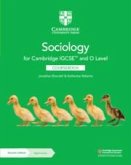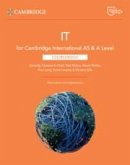Andrew Roberts, John Chamberlain, Mark King
Cambridge International AS & A Level Thinking Skills Coursebook with Digital Access (2 Years)
Versandkostenfrei innerhalb Deutschlands
50,99 €
inkl. MwSt.
Versandkostenfrei*
Erscheint vorauss. 31. März 2026
Melden Sie sich
hier
hier
für den Produktalarm an, um über die Verfügbarkeit des Produkts informiert zu werden.

25 °P sammeln
Andrew Roberts, John Chamberlain, Mark King
Cambridge International AS & A Level Thinking Skills Coursebook with Digital Access (2 Years)
- Broschiertes Buch
Establish a strong foundation in critical thinking and problem-solving skills with the 4th edition of the Cambridge International AS & A Level Thinking Skills coursebook. This edition enhances reasoning, analysis, and logical argumentation by incorporating more real-world examples, questions, and relatable contexts. The range of questions and activities is designed to promote active learning, build student confidence, and deepen understanding.The digital coursebook includes engaging videos. Access your digital resource via Cambridge GO (look inside the front cover for more details).This…mehr
Andere Kunden interessierten sich auch für
![Commerce for Cambridge O Level Coursebook with Digital Access (2 Years) Commerce for Cambridge O Level Coursebook with Digital Access (2 Years)]() Deborah MalpasCommerce for Cambridge O Level Coursebook with Digital Access (2 Years)33,99 €
Deborah MalpasCommerce for Cambridge O Level Coursebook with Digital Access (2 Years)33,99 €![Cambridge IGCSE(TM) and O Level Sociology Coursebook with Digital Access (2 Years) Cambridge IGCSE(TM) and O Level Sociology Coursebook with Digital Access (2 Years)]() Jonathan BlundellCambridge IGCSE(TM) and O Level Sociology Coursebook with Digital Access (2 Years)29,99 €
Jonathan BlundellCambridge IGCSE(TM) and O Level Sociology Coursebook with Digital Access (2 Years)29,99 €![Economics for the IB Diploma Coursebook with Digital Access (2 Years) Economics for the IB Diploma Coursebook with Digital Access (2 Years)]() Ellie TragakesEconomics for the IB Diploma Coursebook with Digital Access (2 Years)67,99 €
Ellie TragakesEconomics for the IB Diploma Coursebook with Digital Access (2 Years)67,99 €![Cambridge International as & a Level Economics Coursebook with Digital Access (2 Years) Cambridge International as & a Level Economics Coursebook with Digital Access (2 Years)]() Colin BamfordCambridge International as & a Level Economics Coursebook with Digital Access (2 Years)70,99 €
Colin BamfordCambridge International as & a Level Economics Coursebook with Digital Access (2 Years)70,99 €![Cambridge International a Level Chinese Language & Literature Coursebook with Digital Access (2 Years) Cambridge International a Level Chinese Language & Literature Coursebook with Digital Access (2 Years)]() Lijing ZhangCambridge International a Level Chinese Language & Literature Coursebook with Digital Access (2 Years)58,99 €
Lijing ZhangCambridge International a Level Chinese Language & Literature Coursebook with Digital Access (2 Years)58,99 €![Cambridge International AS & A Level IT Coursebook with Digital Access (2 Years) Cambridge International AS & A Level IT Coursebook with Digital Access (2 Years)]() Ceredig Cattanach-ChellCambridge International AS & A Level IT Coursebook with Digital Access (2 Years)57,99 €
Ceredig Cattanach-ChellCambridge International AS & A Level IT Coursebook with Digital Access (2 Years)57,99 €![Cambridge International as & a Level Marine Science Coursebook with Digital Access (2 Years) Cambridge International as & a Level Marine Science Coursebook with Digital Access (2 Years)]() Matthew ParkinCambridge International as & a Level Marine Science Coursebook with Digital Access (2 Years)83,99 €
Matthew ParkinCambridge International as & a Level Marine Science Coursebook with Digital Access (2 Years)83,99 €-
-
-
Establish a strong foundation in critical thinking and problem-solving skills with the 4th edition of the Cambridge International AS & A Level Thinking Skills coursebook. This edition enhances reasoning, analysis, and logical argumentation by incorporating more real-world examples, questions, and relatable contexts. The range of questions and activities is designed to promote active learning, build student confidence, and deepen understanding.The digital coursebook includes engaging videos. Access your digital resource via Cambridge GO (look inside the front cover for more details).This coursebook supports the Cambridge International AS & A Level Thinking Skills syllabus (9694) for examination from 2028.
Produktdetails
- Produktdetails
- Verlag: Cambridge University Press
- 4 Revised edition
- Seitenzahl: 480
- Erscheinungstermin: 31. März 2026
- Englisch
- ISBN-13: 9781009819732
- ISBN-10: 1009819739
- Artikelnr.: 75880724
- Herstellerkennzeichnung
- Libri GmbH
- Europaallee 1
- 36244 Bad Hersfeld
- gpsr@libri.de
- Verlag: Cambridge University Press
- 4 Revised edition
- Seitenzahl: 480
- Erscheinungstermin: 31. März 2026
- Englisch
- ISBN-13: 9781009819732
- ISBN-10: 1009819739
- Artikelnr.: 75880724
- Herstellerkennzeichnung
- Libri GmbH
- Europaallee 1
- 36244 Bad Hersfeld
- gpsr@libri.de
How to use this series
How to use this book
Introduction
Chapter 1 Introduction
1.1 Introduction
1.2 Chapter overview
1.3 Past paper questions
1.4 Command words
1.5 Summary
Section 1: Problem solving
Chapter 2 Understanding data in simple formats
2.1 Understanding the information available
2.2 Working out the calculation that is needed
2.3 Selecting which parts of the information are needed
2.4 Different ways to round numbers
2.5 Understanding information in tables
2.6 Understanding information from graphs
2.7 Understanding information in diagrams
2.8 Further sources of information
2.9 Linked activity: Understanding the numbering used in photography
Chapter 3 Deductions and modelling
3.1 Summarising information
3.2 Making deductions
3.3 Applying models
3.4 Linked activity: Logic circuits
Chapter 4 Arranging, searching and finding
4.1 Understanding timetables
4.2 Searching
4.3 Scheduling
4.4 Linked activity: Sharing a chocolate bar
Chapter 5 Communicating reasoning and patterns in data
5.1 Summarising information
5.2 Justifying a solution to a problem
5.3 Checking all the possibilities
5.4 Making estimates and stating assumptions
5.5 Linked activity: Identifying errors in data
Chapter 6 Logical relations and features in data
6.1 Logical relationships between pieces of information
6.2 Identifying features in data
6.3 Using patterns and other features found in data
6.4 Searching for solutions
6.5 Linked activity: Barcodes
Chapter 7 More complex problems
7.1 Making and explaining more complex deductions
7.2 Complex models
7.3 Adapting solutions to problems in response to changes
7.4 Linked activity: Error detection
Section 2: Critical thinking
Chapter 8 Evaluating reasoning (credibility)
8.1 What is 'evaluating evidence'?
8.2 Reliability
8.3 Plausibility
8.4 Corroboration and consistency
8.5 Perspectives presented in evidence
Chapter 9 Evaluate and use statistical evidence
9.1 Representativeness of samples
9.2 Design of questionnaires
9.3 Issues with the way data is presented
Chapter 10 Use of evidence
10.1 Explanations
10.2 Inferences
10.3 Assessing how well evidence supports a particular claim
Chapter 11 Arguments
11.1 Distinguishing between arguments and other types of text
11.2 Argument elements
11.3 Assumptions
11.4 Analysing the structure of arguments
Chapter 12 Evaluating reasoning
12.1 Fallacies (flaws)
12.2 Other potential causes of weakness
12.3 Appeals
12.4 Analogies
12.5 Identifying weaknesses in documents
Chapter 13 Constructing arguments and explanations
13.1 Introduction to constructing arguments and explanations
13.2 Argument elements which can strengthen reasoning
153.3 Arguments and explanations based on source material
13.4 Arguments not based on given sources
Chapter 14 Preparing for assessment
14.1 Introduction
14.2 The format of the assessment
14.3 How to approach questions
14.4 Revision tips
14.5 Some final thoughts
Glossary
Index
Acknowledgements.
How to use this book
Introduction
Chapter 1 Introduction
1.1 Introduction
1.2 Chapter overview
1.3 Past paper questions
1.4 Command words
1.5 Summary
Section 1: Problem solving
Chapter 2 Understanding data in simple formats
2.1 Understanding the information available
2.2 Working out the calculation that is needed
2.3 Selecting which parts of the information are needed
2.4 Different ways to round numbers
2.5 Understanding information in tables
2.6 Understanding information from graphs
2.7 Understanding information in diagrams
2.8 Further sources of information
2.9 Linked activity: Understanding the numbering used in photography
Chapter 3 Deductions and modelling
3.1 Summarising information
3.2 Making deductions
3.3 Applying models
3.4 Linked activity: Logic circuits
Chapter 4 Arranging, searching and finding
4.1 Understanding timetables
4.2 Searching
4.3 Scheduling
4.4 Linked activity: Sharing a chocolate bar
Chapter 5 Communicating reasoning and patterns in data
5.1 Summarising information
5.2 Justifying a solution to a problem
5.3 Checking all the possibilities
5.4 Making estimates and stating assumptions
5.5 Linked activity: Identifying errors in data
Chapter 6 Logical relations and features in data
6.1 Logical relationships between pieces of information
6.2 Identifying features in data
6.3 Using patterns and other features found in data
6.4 Searching for solutions
6.5 Linked activity: Barcodes
Chapter 7 More complex problems
7.1 Making and explaining more complex deductions
7.2 Complex models
7.3 Adapting solutions to problems in response to changes
7.4 Linked activity: Error detection
Section 2: Critical thinking
Chapter 8 Evaluating reasoning (credibility)
8.1 What is 'evaluating evidence'?
8.2 Reliability
8.3 Plausibility
8.4 Corroboration and consistency
8.5 Perspectives presented in evidence
Chapter 9 Evaluate and use statistical evidence
9.1 Representativeness of samples
9.2 Design of questionnaires
9.3 Issues with the way data is presented
Chapter 10 Use of evidence
10.1 Explanations
10.2 Inferences
10.3 Assessing how well evidence supports a particular claim
Chapter 11 Arguments
11.1 Distinguishing between arguments and other types of text
11.2 Argument elements
11.3 Assumptions
11.4 Analysing the structure of arguments
Chapter 12 Evaluating reasoning
12.1 Fallacies (flaws)
12.2 Other potential causes of weakness
12.3 Appeals
12.4 Analogies
12.5 Identifying weaknesses in documents
Chapter 13 Constructing arguments and explanations
13.1 Introduction to constructing arguments and explanations
13.2 Argument elements which can strengthen reasoning
153.3 Arguments and explanations based on source material
13.4 Arguments not based on given sources
Chapter 14 Preparing for assessment
14.1 Introduction
14.2 The format of the assessment
14.3 How to approach questions
14.4 Revision tips
14.5 Some final thoughts
Glossary
Index
Acknowledgements.
How to use this series
How to use this book
Introduction
Chapter 1 Introduction
1.1 Introduction
1.2 Chapter overview
1.3 Past paper questions
1.4 Command words
1.5 Summary
Section 1: Problem solving
Chapter 2 Understanding data in simple formats
2.1 Understanding the information available
2.2 Working out the calculation that is needed
2.3 Selecting which parts of the information are needed
2.4 Different ways to round numbers
2.5 Understanding information in tables
2.6 Understanding information from graphs
2.7 Understanding information in diagrams
2.8 Further sources of information
2.9 Linked activity: Understanding the numbering used in photography
Chapter 3 Deductions and modelling
3.1 Summarising information
3.2 Making deductions
3.3 Applying models
3.4 Linked activity: Logic circuits
Chapter 4 Arranging, searching and finding
4.1 Understanding timetables
4.2 Searching
4.3 Scheduling
4.4 Linked activity: Sharing a chocolate bar
Chapter 5 Communicating reasoning and patterns in data
5.1 Summarising information
5.2 Justifying a solution to a problem
5.3 Checking all the possibilities
5.4 Making estimates and stating assumptions
5.5 Linked activity: Identifying errors in data
Chapter 6 Logical relations and features in data
6.1 Logical relationships between pieces of information
6.2 Identifying features in data
6.3 Using patterns and other features found in data
6.4 Searching for solutions
6.5 Linked activity: Barcodes
Chapter 7 More complex problems
7.1 Making and explaining more complex deductions
7.2 Complex models
7.3 Adapting solutions to problems in response to changes
7.4 Linked activity: Error detection
Section 2: Critical thinking
Chapter 8 Evaluating reasoning (credibility)
8.1 What is 'evaluating evidence'?
8.2 Reliability
8.3 Plausibility
8.4 Corroboration and consistency
8.5 Perspectives presented in evidence
Chapter 9 Evaluate and use statistical evidence
9.1 Representativeness of samples
9.2 Design of questionnaires
9.3 Issues with the way data is presented
Chapter 10 Use of evidence
10.1 Explanations
10.2 Inferences
10.3 Assessing how well evidence supports a particular claim
Chapter 11 Arguments
11.1 Distinguishing between arguments and other types of text
11.2 Argument elements
11.3 Assumptions
11.4 Analysing the structure of arguments
Chapter 12 Evaluating reasoning
12.1 Fallacies (flaws)
12.2 Other potential causes of weakness
12.3 Appeals
12.4 Analogies
12.5 Identifying weaknesses in documents
Chapter 13 Constructing arguments and explanations
13.1 Introduction to constructing arguments and explanations
13.2 Argument elements which can strengthen reasoning
153.3 Arguments and explanations based on source material
13.4 Arguments not based on given sources
Chapter 14 Preparing for assessment
14.1 Introduction
14.2 The format of the assessment
14.3 How to approach questions
14.4 Revision tips
14.5 Some final thoughts
Glossary
Index
Acknowledgements.
How to use this book
Introduction
Chapter 1 Introduction
1.1 Introduction
1.2 Chapter overview
1.3 Past paper questions
1.4 Command words
1.5 Summary
Section 1: Problem solving
Chapter 2 Understanding data in simple formats
2.1 Understanding the information available
2.2 Working out the calculation that is needed
2.3 Selecting which parts of the information are needed
2.4 Different ways to round numbers
2.5 Understanding information in tables
2.6 Understanding information from graphs
2.7 Understanding information in diagrams
2.8 Further sources of information
2.9 Linked activity: Understanding the numbering used in photography
Chapter 3 Deductions and modelling
3.1 Summarising information
3.2 Making deductions
3.3 Applying models
3.4 Linked activity: Logic circuits
Chapter 4 Arranging, searching and finding
4.1 Understanding timetables
4.2 Searching
4.3 Scheduling
4.4 Linked activity: Sharing a chocolate bar
Chapter 5 Communicating reasoning and patterns in data
5.1 Summarising information
5.2 Justifying a solution to a problem
5.3 Checking all the possibilities
5.4 Making estimates and stating assumptions
5.5 Linked activity: Identifying errors in data
Chapter 6 Logical relations and features in data
6.1 Logical relationships between pieces of information
6.2 Identifying features in data
6.3 Using patterns and other features found in data
6.4 Searching for solutions
6.5 Linked activity: Barcodes
Chapter 7 More complex problems
7.1 Making and explaining more complex deductions
7.2 Complex models
7.3 Adapting solutions to problems in response to changes
7.4 Linked activity: Error detection
Section 2: Critical thinking
Chapter 8 Evaluating reasoning (credibility)
8.1 What is 'evaluating evidence'?
8.2 Reliability
8.3 Plausibility
8.4 Corroboration and consistency
8.5 Perspectives presented in evidence
Chapter 9 Evaluate and use statistical evidence
9.1 Representativeness of samples
9.2 Design of questionnaires
9.3 Issues with the way data is presented
Chapter 10 Use of evidence
10.1 Explanations
10.2 Inferences
10.3 Assessing how well evidence supports a particular claim
Chapter 11 Arguments
11.1 Distinguishing between arguments and other types of text
11.2 Argument elements
11.3 Assumptions
11.4 Analysing the structure of arguments
Chapter 12 Evaluating reasoning
12.1 Fallacies (flaws)
12.2 Other potential causes of weakness
12.3 Appeals
12.4 Analogies
12.5 Identifying weaknesses in documents
Chapter 13 Constructing arguments and explanations
13.1 Introduction to constructing arguments and explanations
13.2 Argument elements which can strengthen reasoning
153.3 Arguments and explanations based on source material
13.4 Arguments not based on given sources
Chapter 14 Preparing for assessment
14.1 Introduction
14.2 The format of the assessment
14.3 How to approach questions
14.4 Revision tips
14.5 Some final thoughts
Glossary
Index
Acknowledgements.







